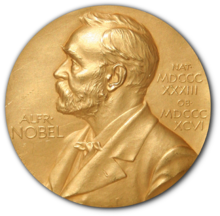
This is the most wondrous story in our advent calendar.
The two German physicists Max von Laue and James Franck won the Nobel Prize in 1914 and 1925 respectively. When the Nazis grew strong in Germany von Laue and Franck sent their medals, made of 23-karat gold, to Niels Bohr in Copenhagen. During these troublesome times many people were hiding or burying their family jewelry or anything of timeless value that they wanted to keep out of the Gestapo's hands, though it was illegal to send valuables out of country.
Unfortunately, by 1940 the Nazis made it to Copenhagen. Bohr was now in possession of two large gold pieces that carried von Laue's and Franck's names and clearly left Germany unapproved. Bohr had to get rid of the Nobel medals, and quickly so. It was Georgy de Hevesy, a colleague and friend from the department of chemistry, who came up with a ingeneous solution, quite literally: he would dissolve the medals.
Now gold is a precious metal and what makes it so precious is that it is slow to react with anything. It takes a mixture of acids known as aqua regia and time to dissolve gold, but at the end of a seemingly endless afternoon the medals were gone and left was a glass with a bright orange solution that didn't catch the interest of the Nazis.
But that wasn't the end of the story. After the war, de Hevesy returned to his lab and found the orange solution undisturbed in his shelf. He precipitated out the gold and sent it back to the Nobel Foundation in Stockholm. They recast the medals and gave them back to von Laue and Franck.
De Hevesy won the Nobel price for chemistry in 1943.
This story can be found in many books. It was recently told in some more details at NPR blogs: Dissolve my Nobel Prize! Fast!.

Hi Bee,
ReplyDeleteThanks as it being yet another nice story to which I wasn't privy before. Then again despite what de Hevesy did the information regarding the two medals is still to be found in the universe; that is unless it fell into a black hole of course. However rumor has it that there are those that would disagree :-)
Best,
Phil
That's a wonderful story (although set against the rather horrendous background of the Nazis' spread across Europe). How remarkable for the medals to ultimately be cast again from the same gold!
ReplyDeleteWhat an amazing story!
ReplyDeleteThis comment has been removed by the author.
ReplyDeleteDissolving gold requires a coordinating ligand plus an oxidant. Saltwater (chloride) plus air will do it (slowly), as will cyanide in water plus air (solution heap mining), producing soluble [AuCl2]- and [Au(CN)2]- respectively, Au(I).
ReplyDeleteAqua regia, 82 vol-% 15M HCl plus 18 vol-% 12M HNO3 then aged about 15 minutes (keep covered, fumes!), goes through gold like a buzz saw. Huge chloride concentration is abetted by powerful oxidants NOCl and some free chlorine to obtain [AuCl4]-, Au(III).
Recover the gold with a mild reductant... but NEVER with ammonia ("explosive gold").